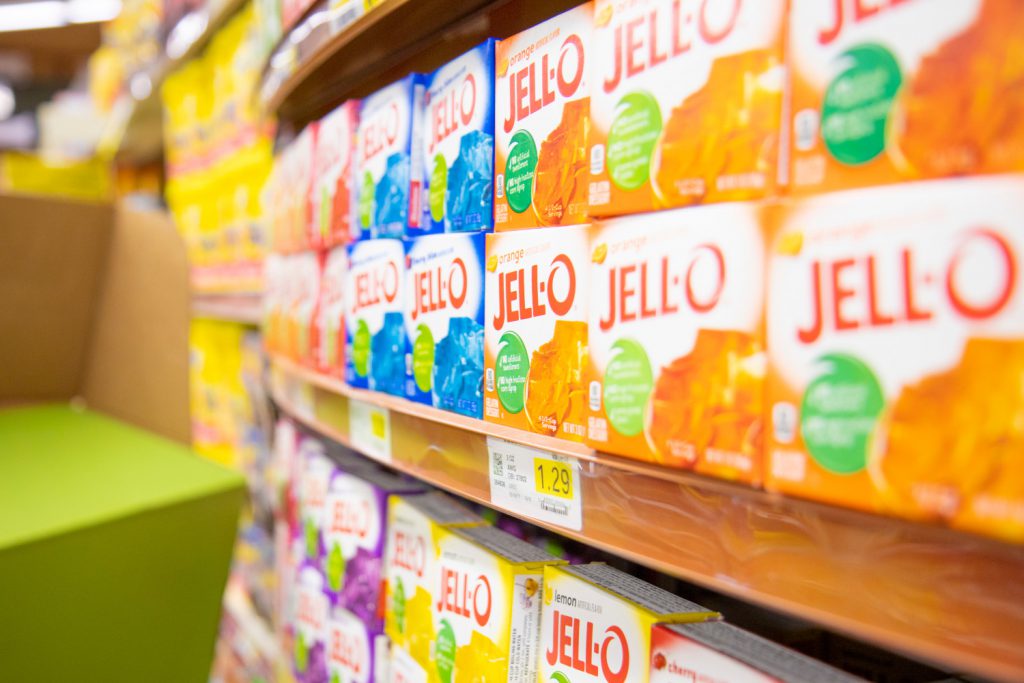
Hi dog owners!
Do you ever notice yourself in the kitchen mixing hot water in something, putting it in a mold, and trying to put that mold inside the freezer, but having your dog yearning to have a taste of what you’re making?
Or do you ever notice your dog trying so hard to get to that jelly dessert you prepared for your kids?
Well, at this point, I’m sure you already know where this is heading.
Is it okay to let your dog eat Jello (can dogs eat jello)?
Well, we’ll be looking at the super tasty dessert and scrutinizing if it’s a good treat for your dog.
You might also like our recent article “best dog food for blue heeler“ which is available on a separate page as a detailed resource for food for blue heeler pups.
WHAT IS JELLO?
Jello is a sweet jelly-like substance that has gelatin as its main ingredient. Gelatin is from animal collagen. Collagen is a product gotten by boiling the bones and hides of selected animals, usually cows and pigs. After boiling the hides and bones, the extract is dried and then treated with a strong acid or base and then filtered till the collagen is extracted.
The collagen is further dried, blended into a fine powdery substance, and then sifting to gelatin.
Although gelatin seems to be the main ingredient used to make Jello, it only stands as the substance that gives Jello its gel-like and jiggly feel. Other main additives that consist of the production of jello include; flavor, color, and artificial sweeteners.
HOW DOES JELLO AFFECT MY DOG?
Fun fact:
Jello isn’t particularly good or bad for your dog. It just depends on how you feed it to your dog.
Why so?
Well, on the brighter side, jello contains gelatin. Gelatin consists of collagen, which has essentials animal proteins. These proteins come from body parts of animals like the bones and skins of pigs and cows. These proteins are adequate for your dog as they contribute positively to your dog’s health in the form of a protein supply. On the downside, jello contains specific ingredients that may be bad for it.
The first unacceptable ingredient contained in jello is high amounts of sugar. Now, most jellos consists of a lot of sugars. The sugar gives the gelatin mix a sweet and palatable taste.
While this may be consumable by humans, it is wrong to allow your dog to consume jello that contains such high amounts of sugar.
As humans, sugar in high quantity is terrible for our bodies and may cause us many problems, but sugar is even worse for dogs. Most dogs do have a sweet tooth, but letting them consume jello that contains such high amounts of sugar can lead to many complications in the dog’s health.
Therefore, jellos can make your dog overweight, result in pancreatic issues, or even cause them to develop problems with their teeth.
Sugar Is Bad For Your Dog
Some people may say; well, if sugar is bad for my dog, I’ll get a sugar-free or no-sugar jello for my dog instead. Well, I’ve got bad news; most no-sugar jello contains a substance that poses an enormous threat to your dog than sugar.
This substance is called xylitol. Xylitol is a substance that stands as a substitute for sugar in no-sugar confectionaries. It is also known as artificial sugar. It is a transparent solid substance that is dissolvable in water.
Xylitol is under the class of polyalcohols and sugar alcohol. So anywhere you find a no-sugar or sugar-free product, be sure that it contains xylitol. So why is xylitol a terrible additive for my dog?
Xylitol Can be Life Threatening
Xylitol can cause a dog to completely shut down within a time frame of 30-90 minutes. Yes, it acts that quick on dogs. For every dog’s kilogram weight, 100 milligrams (mg) of xylitol consumed can result in hypoglycemia or low blood sugar, which is extremely dangerous for the dog.
The most apparent symptom of hypoglycemia is vomiting. After the dog vomits, you may also notice other symptoms such as tiredness and a complete loss of control over its muscles, also known as ataxia. At doses above 500 milligrams per kilogram body weight, the effect may be Liver failure, a difficulty in the coagulation of the dog’s blood, and disseminated intravascular coagulation.
The Serious Outcomes Of Eating Jello
The resulting symptoms may include; shortness of breath and blood in your dog’s urine or stool. From the above, it’s clear that xylitol is not just bad for your dog’s health, it is life-threatening, and it’ll be foolish of anyone to let their dogs consume any substance that contains xylitol.
Any dog owner who places real value on his dog’s life would never consider feeding his dog jellos, especially when he’s aware of what the resulting side effects are. Other essential ingredients that makeup jello is flavor and color. Jellos comes in so many different flavors. Jello has well over 30 different flavors in production. These flavors also come in different colors. Although most natural fruit flavors are great for your dog, you can never be sure of what artificial food flavors and colorings contain. As a result of this, letting your dog consume jello is a bad idea.
So to answer the question;
So Can Dogs Consume Jello?
For the sake of the fact that most jellos contain substances that are dominantly harmful to the dog and stand as a threat to the dog, it is more advisable to avoid letting your dog eat jello. Some people may believe that jello contains gelatin, which is okay for dogs.
Well, yes, the only healthy ingredient in jello is gelatin. Some dog owners find Gelatin supplementation can increase energy and alertness in their dogs. It can also help to sustain muscles, ligaments, and cartilage.
And because gelatin is okay for your dog’s health, certain circumstances may permit you to feed your dog jello; make it yourself. You can exclude those ingredients that pose a threat to your dog’s health by making it yourself. When making jello for your dog, all you need to do is make use of only the gelatin while making it.
You mix the gelatin in hot water and mix it. While mixing, stir in some cold water, and pour the gelatin into your mold. Allow the mix to cool in the refrigerator before serving it to your dog.
Another way to make this recipe riveting is by pouring the jello mix in ice cubes instead of molds. That way, you can serve it to your dog as a bite-sized treat that it can consume in small quantities. This is good because it’ll help you monitor the amount of jellos your dog consumes as accurately as possible.
Apart from these two methods, you may decide to take things a step further by adding dog treats and kibbles or low sodium chicken broth to the jello mix. As this makes it a lot more interesting for your dog, adding these ingredients encourages healthy and fun ways to consume a treat and substitute for the flavors and food colors that the real jello comes in.
Conclusively,
The jello brand product is very harmful to the health of your dog. It poses a threat to your dog’s existence, as most dogs do have a sweet tooth and may want to consume the treat. However, no dog owner should let his dog consume jello even in bite-size quantity.
On the other hand, because of jellos’ gelatin content, which is good for the dog, you may opt for making your homemade jello treat for your dog. And where you find it hard to make your jello at home, it’s only fair that you sprinkle the gelatin on your dog’s food.
By doing this, your dog won’t be missing out on the nutritional value that gelatin has to offer.
To continue our efforts of dog owners education, we publish two new similar resources, Can Dogs Eat Grits and Can Dogs Eat Maple Syrup, available on separate pages.
